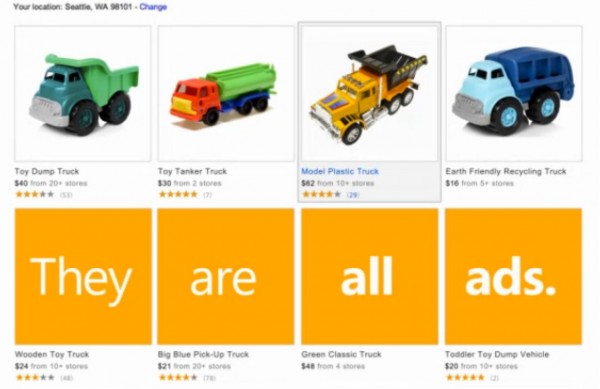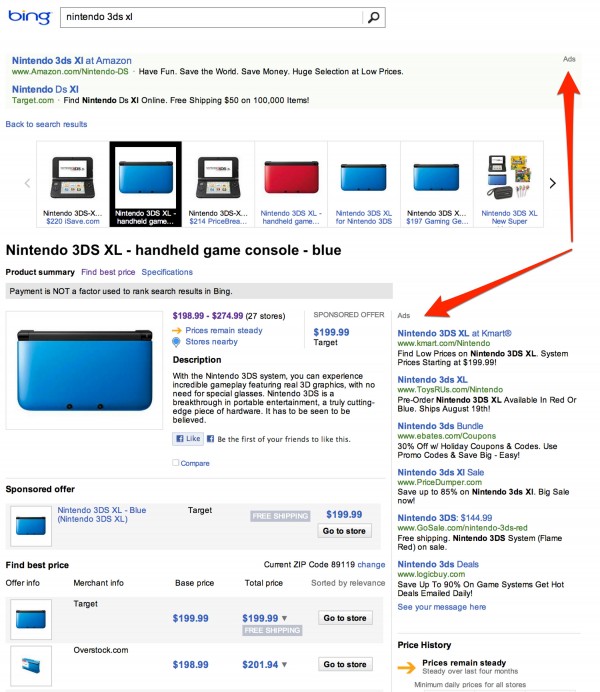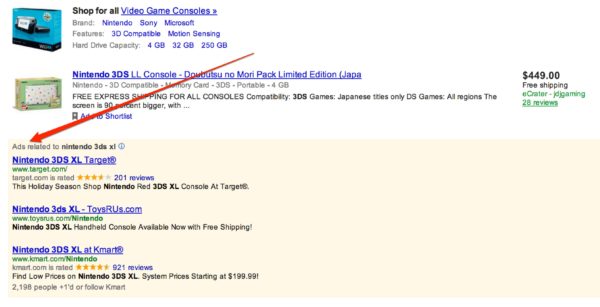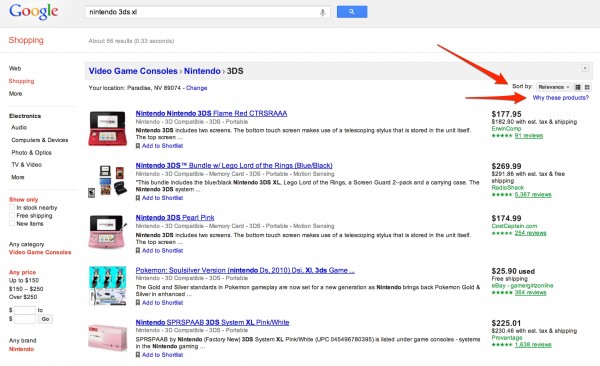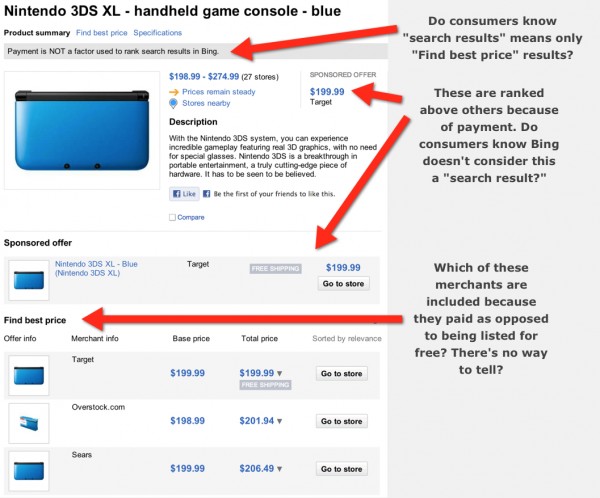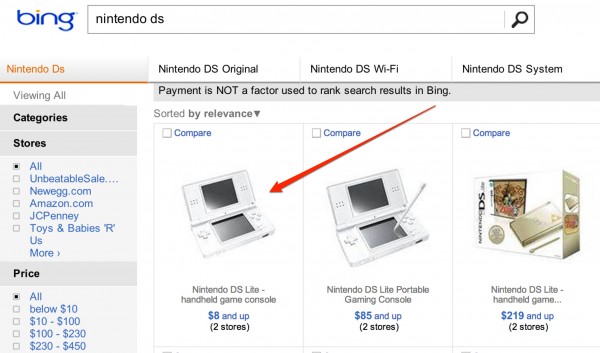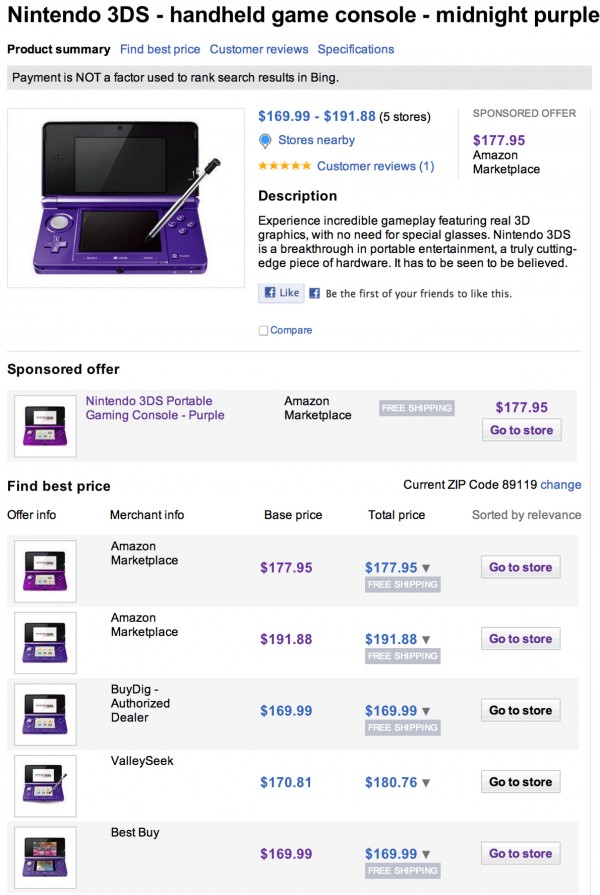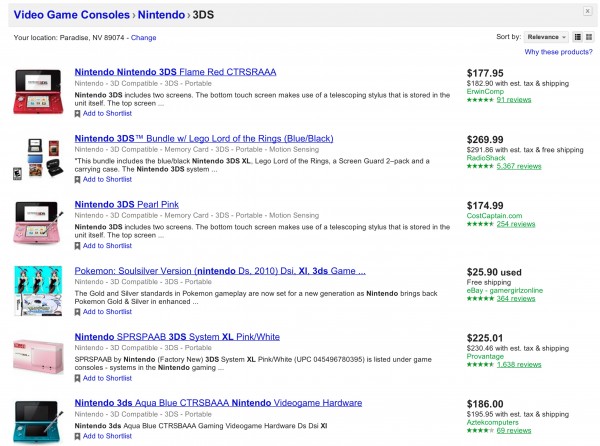Bing Shopping As A Poster Child For Consumer Confusion About Ads
Bing has been escalating its attacks against Google Shopping over consumer transparency since launching its “Scroogled” campaign just over a week ago. Well, consumer confusion is a serious issue. Indeed, Bing itself can be used to illustrate some of the problems consumers face at both Bing and Google. The day after Bing’s campaign launched, I […]
Bing has been escalating its attacks against Google Shopping over consumer transparency since launching its “Scroogled” campaign just over a week ago. Well, consumer confusion is a serious issue. Indeed, Bing itself can be used to illustrate some of the problems consumers face at both Bing and Google.

Meanwhile, at least one blogger has gotten a “Scroogled” t-shirt, and the official Bing blog has done two further anti-Google posts.
The post from December 4th chastises Google for not responding to Bing’s campaign. Bing wrote:
How did Google respond? They distributed a statement praising their service. They highlighted how great products look on Google Shopping without really explaining how the products get there in the first place. They did not contradict or argue any of the facts and information we laid out. The silence is disappointing given how important this issue is to consumers and the online industry as a whole.
In short, Google’s silence is pretty clear acknowledgement of the changes they have made to introduce pay-to-rank to their system.
After calling the practice “evil” for years, Google Shopping is now allowing merchants to pay to influence where their products show up in Google Shopping’s rankings….
We also believe the more Google blurs the line between rankings and ads, and the more consumers learn about these changes, they will realize they have a choice when it comes to search and try Bing.
Welcome To Bizarro World
Reading that post left me feeling like Bing has entered the same bizarro world Google occupied earlier this year, when it tried say it wasn’t doing the paid inclusion that it absolutely was. Both companies have now given me serious WTF moments, where I simply cannot believe they can, with a straight face, make statements that just aren’t true.
Moreover, I remain appalled that they do these things despite US Federal Trade Commission guidelines designed to protect consumers. It remains a further sign that the search engine industry doesn’t appear to have any real concern or regard for those guidelines.
Google’s About-Face On Paid Inclusion
Google has tried to suggest that “paid inclusion” means that you aren’t clearly labeling paid results, rather that the common definition that it means you’re charging people to be in your search engine.
Google is pushing this redefinition, in my opinion, because it makes it seem like Google hasn’t done a complete reversal from its previous stance against paid inclusion. I’ve called Google out in detail about this in depth three times now, and the stories below explain more:
- Once Deemed Evil, Google Now Embraces “Paid Inclusion”
- Google Product Search To Become Google Shopping, Use Pay-To-Play Model
- On Google Earnings Call, Google Ignores FTC Definition Of “Paid Inclusion”
I’ve also felt the search engine industry as a whole has ignored these guidelines or had serious issues with them to the degree I wrote to the FTC asking for it to review the current state of compliance. At the very least, it began to feel tiresome as a journalist to be writing about the guidelines as if they had any force if, in reality, perhaps they no longer held. My stories below cover more about this:
- A Letter To The FTC Regarding Search Engine Disclosure Compliance
- FTC On Search Engine Disclosure: Aware Of Issues, No Further Comment
- SEMPO: FTC Is “Strongly Considering” Review Of How Search Engines Disclose Paid Listings
The FTC has remained silent on the issue, though the rumor is that the agency will do some type of review. But while the FTC has been silent, Bing has apparently found new religion that consumers should understand how search results are formed and when payment plays a role.
Bing Seeks Consumer Clarity!
From Bing’s statement above, it critized Google for not “really explaining how the products get there” and that it “blurs the line between rankings and ads” and “how important this issue is to consumers and the online industry as a whole.”
I agree. It is an important issue. I’m glad that Bing is elevating it for further attention. But I remain amazed that it’s doing so while Bing itself can be a poster child for all the flaws it calls out Google for.
I already covered how payment plays a role in Bing’s rankings. Now I’m going to revisit the issue of consumer confusion, about how difficult it is for a consumer to know what’s an ad and what’s not.
Can You Spot The Ads?
Let me start with this from one of Bing’s anti-Google commercials:
The commercial asks if you can spot the ads in Google’s shopping results, then says it’s easy because, “They’re all ads.”
Here’s the thing. Can you spot the ads in Bing’s shopping results? It’s not easy, because some of them are ads, some aren’t, but they’re all mixed together so that there’s no easy way for a typical consumer to tell. It’s difficult even for an expert in search engines to know.
Aren’t The Ads Marked “Ads?”
Now Bing would likely say that it’s easy to tell the ads at Bing, because they are all marked “ads,” as the arrows show below:
Those are the ads, right, because they say “ads” just as Bing promised: “Where we do have ads, we label them clearly as ads.”
So what’s the problem Bing has with Google? After all, Google clearly labels ads in Google Shopping, as you can see here where ads appear at the bottom of search results:
Ah, but Bing’s talking about the stuff above those ads. Bing’s saying that the search results themselves at Google Shopping really are ads, these results:
In addition, Bing continues to say that when Google says these results are sorted by relevance, as the first arrow shows, they are in reality a way for people who pay more to rank higher. As further proof, it highlights what the second arrow points to, the “Why these products” label that, if you click on it, brings up this disclosure:
Products and offers that match your query. Google is compensated by these merchants. Payment is one of several factors used to rank these results.
Bing’s entirely correct that these are indeed ads that do not carry an ad label. If you want to appear in these results, you have to purchase what are called “Product Listing Ads.” Using Google’s own words, these are ads. It just doesn’t call them that.
How misleading! But then again, Google’s actually doing a better job of disclosing these ads than Bing does, when it carries the exact same type of ads. That leads back to the wonderful world of “paid inclusion,” which are the type of ads in question.
Two Types Of Ads: Paid Placement & Paid Inclusion
Back in the early days of search engines, there were two major types of advertising programs:
- Paid Placement
- Paid Inclusion
Paid placement was when advertisers paid to help ensure they received prominent placement. It has turned into the ads many are use to finding on both Google and Bing today, the ads called “Ads” in both places. Payment alone doesn’t guarantee a higher ranking in these ads. It’s one of several factors considered, but it can help.
The FTC defined paid placement as part of the disclosure guidelines it created in June 2002 to be:
Any program in which individual Web sites or URLs can pay for a higher ranking in a search results list, with the result that relevancy measures alone do not dictate their rank.
Paid inclusion was when advertisers paid to be included in search results but where payment didn’t necessarily help or have a greater influence over other factors for them to rank well. Paid inclusion programs died out over the years for web search, but they’ve remained common for vertical search such as travel and shopping.
The FTC defined paid inclusion in June 2002 to be:
Any program in which individual Web sites or URLs are included in a search engine’s index, or pool, of sites available for display as search results, when that Web site or URL might not otherwise have been included, or might not have been included at a particular point in time, but for participation in the paid program.
Knowing these definitions is crucial for understanding if a search engine is actually being misleading to consumers according to the disclosure guidelines the FTC has for both type of ads.
Paid Placement Ads Need Ad Label
When it comes to paid placement ads, the FTC wants some type of “ad” label applied to them. The guidelines say:
The staff recommends, if your search engine uses paid placement, you make any changes to the presentation of your paid-ranking search results that would be necessary to clearly delineate them as such, whether they are segregated from, or inserted into, non-paid listings. Factors to be considered in making such a disclosure clear and conspicuous are prominence, placement, presentation (i.e., it uses terms and a format that are easy for consumers to understand, and that do not contradict other statements made), and proximity to a claim that it explains or qualifies.
Paid Inclusion Ads Need Explanation, Not Label
When it comes to paid inclusion ads, the FTC isn’t concerned about these ads being called ads but rather wants some type of easily located explanation of how the search engine selects sites for its search results, if paid inclusion is part of the mix. The guidelines say:
The staff recommends that if your search engine uses paid inclusion programs that may distort rankings or placement criteria, you clearly describe how sites are selected for inclusion in your indices. Also, consumers should be able to easily locate your explanation of the paid inclusion program you use, and discern the impact of paid inclusion in search results lists.
Finally, the staff recommends that you review your Web sites to ensure that:
- any paid ranking search results are distinguished from non-paid results with clear and conspicuous disclosures;
- the use of paid inclusion is clearly and conspicuously explained and disclosed; and
- no affirmative statement is made that might mislead consumers as to the basis on which a search result is generated.
Google Explains Paid Inclusion As Required
So when Bing slams Google Shopping for having ads that aren’t labeled as ads, it’s talking about Google’s paid inclusion ads — and these are ads that the FTC itself isn’t asking to be labeled ads.
Instead, the FTC wants an explanation about how these ads are integrated into results, and that’s exactly what Google provides:
The explanation could be better if it explicitly said there are some merchants not included, because they don’t pay. But technically, “Google is compensated by these merchants” implies this.
Bing Doesn’t Explain Paid Inclusion As Required
I can’t show you Bing’s disclosure of paid inclusion at its Bing Shopping site because Bing doesn’t have any.
Just as with Google, some merchants at Bing appear within Bing Shopping because they run paid inclusion ads. Just as with at Google, these paid inclusion ads are not labeled as ads, nor do they have to be. But there should be an explanation that paid inclusion is involved. There’s not, and that seems to be in violation of the FTC’s guidelines.
I find myself dumbfounded how Bing does this, attacks Google about consumer disclosure when it doesn’t appear to be providing the disclosure it is required to in the first place. At the very least, you’d have thought someone at Bing would have gotten the disclosure house in order before going on the attack.
Worse, while Bing has long failed to provide adequate disclosure, it added this reassuring statement to the top of its shopping search results last week:
“Payment is NOT a factor used to rank search results in Bing.” Well, that’s true in the sense that Bing says while payment is involved, it’s not one of the factors evaluated for ranking purposes, as is the case at Google (Bing overstates the role of payment at Google, but I’ll get back to that).
You could argue that if someone isn’t included because they didn’t pay to get in, then they can’t rank at all, so payment is a factor. But I think the bigger issue is that the FTC specifically warns against “affirmative statements that might mislead consumers.” Bing’s failure to disclose paid inclusion, added with an affirmative assertion about payment not being a ranking factor as part of a campaign against Google, potentially could be deemed misleading.
Again, Can You Spot The Ads?
Now let me step back from the specific guidelines and revisit the bigger reason why they were created. The FTC was concerned that consumers assumed that all search results were ranked solely by relevancy, with payment having no role. The reality was that payment was having an impact, so the FTC wanted to ensure consumers understood when payment was involved, in varying degrees.
That leads to a real shopping search I did this week, for an actual product I purchased, a Nintendo 3DS XL. Here’s how that looks on Bing:
At the very top of these results is a “Sponsored Offer” from Target, which is ranking above all the other search results because of payment. Directly above it is a statement saying that search results aren’t ranked by payment.
Now, I know that Bing means the Sponsored Offer listing isn’t part of what it considers to be “search results.” Many search marketers understand that. But do consumers?
The second highest ranked listing is again from Target, again under a “Sponsored Offer” heading but otherwise looking a lot like those “Find best price” listings that Bing considers to be “search results.”
The third highest ranked listing is again from Target, this time within the “Find best price” area that, without question, should be where payment isn’t a ranking factor, according to Bing. Below that are other listings. Is the Target listing a paid inclusion ad? Are the other listings paid inclusion ads?
The only way to know is to hover your mouse over the URLs for each listing and see if they point directly to the merchant or not. With Target and Sears, they actually point to Dealtime.com, which is part of Shopping.com, which is the paid inclusion provider that Bing partners with. These are almost certainly paid inclusion ads. Overstock goes through Mercent, which helps merchants with feeds, and I’m betting it’s not a paid inclusion listing. But it could be. I can’t tell. The typical consumer certainly can’t.
You tell me. Are these results meeting Bing’s goal that a search engine should explain how products get into its listings, that there shouldn’t be a blurring of the line between rankings and ads? I sure think there’s a lack of clarity.
What Is Relevancy?
As part of its campaign, Bing’s taken big swings at Google telling consumers that results are sorted by relevance. Bing repeatedly suggests that in reality, Google’s running some type of pay-to-rank-better shopping service.
Google hasn’t said that its shopping search engine operates that way. Payment is part of the equation, yes, and is certainly disclosed. But many searches actually bring up matching products, not matching merchants. When merchants are listed, I’ve not gotten the impression Google may have bad rankings because merchants are paying to ruin relevancy. Google Shopping just seems to have relevancy issues.
That brings me back to Bing, because remember those “Find best price” results that listed Target first? The results that aren’t supposed to be influenced by payment, even by Target, which we know is paying Bing to be a Sponsored Offer elsewhere on the search page?
Those results are sorted by relevance. It says so right above the listings. Wouldn’t you think that “Find best price” results would be best sorted for relevance by price? But that’s not the case. If you want that, you have to go to the bottom of the five stores listed, find the small “see all 27 stores” link, click on that in order to get this list:
In this list by price, Target comes fifth. Two stores actually have it cheaper, something you wouldn’t have known from Bing’s default “relevant” results. Why? Why especially was Walmart, a well-known merchant competitive with Target and selling the product for three cents cheaper, not part of the default listing?
It’s probably not because of Walmart’s not doing paid inclusion. As best I can tell, it is. NextWarehouse doesn’t appear to be. But the bigger point is that if you’re going to throw stones about relevancy, perhaps your own relevancy shouldn’t be in question either?
Dropping Free Listings Doesn’t Seem To Be Helping Bing
Speaking of relevancy, Bing has turned off the ability for new people to submit for free to Bing Shopping, opening it up to criticisms that it’s moving toward doing exactly what Google does, a pure pay-to-play system.
When I raised this as part of my original article last week, Bing quickly said this was a temporary thing done to protect the integrity of its systems during the holiday rush, something it apparently also did last year, and that free submission will return.
Oddly, the program closed well ahead of the holiday period, on September 12, with a notice that was placed on this support page, with no mention it was returning. Now the page has been updated, with the original closure date gone and Bing’s new explanation that this is all some temporary shutdown put in place.
Shouldn’t this closure help ensure I don’t get issues like this:
That Nintendo DS Lite isn’t selling for $8, honest. It’s a power adapter for the unit that Bing has clustered in with a console, throwing things off. But I sure felt, what would you call it, Bingled?, when I went in hoping for a great deal.
How about this:
Why am I getting two listings from “Amazon Marketplace” rather than one? Is there any reason I’d want an option to buy from a second vendor there at a higher price?
Why is that the same Amazon Marketplace vendor that is listed twice above the search results as a sponsored offer also showing as the most relevant “Find best price” merchant despite a price that’s $8 higher than two other merchants?
Make no mistake. There are plenty of problems with relevancy over at Google Shopping. I’ve covered some of them before in The Mess That Is Google Shopping, but look also at this. Here’s a search on Google, regular Google, for Nintendo 3DS XL:
See the big sponsored shopping ads box on the right? Great content: listings from Target, ToysRUs, Walmart, Sears and for the exact product I want.
How come when I click through on that to go into Google Shopping, or when I go directly to Google Shopping and do the same search, I get this mess:
For whatever reason, Google drops the “XL” part of my search — so I get matching results for the Nintendo DS, which lack any major brands as well as the product I was after.
Shopping Search Sucks & Paid Inclusion Ain’t To Blame
Still with me? Let’s wrap it up. Shopping search isn’t a pretty picture at Google or Bing. I can find giant fails for a variety of products with both of them, with little effort.
The fails seem to have little to do with the paid inclusion model. Yes, Bing includes some people for free that Google will miss. In some cases, this makes Bing more comprehensive. But in other cases, it might not help or even make it worse.
Similarly, Google may lack some listings that Bing has, which might make it worse, but not always. But the shift to an all-paid model certainly hasn’t produced any game-changing relevancy improvements that I’ve seen.
Google Looks Bad For Unpaid Exclusion
Google’s certainly going to earn more off shopping search, of course. But it comes at a cost to its reputation. Even with Bing’s campaign twisting things and Bing itself having issues, attention is being raised to Google’s new, exclusionary practice.
It’s a shame. Google fought the battle against paid inclusion, and there were good reasons for it to have done so. The fact that Google Shopping was, until recently, the only major all-free shopping search made Google a white knight player in the space.
Bing Looks Bad For Poor Disclosure & No Better Product
As for Bing, you know what would have been far better than attacking Google? Dropping its paid inclusion program altogether and actually producing a self-evidently better shopping search engine.
That would have given Bing a real one-two punch. It really would have had the “honest” shopping search engine it’s professing to be, and it also would have had a relevant search engine that might actually have attracted and kept searchers on its merits.
A better product. Imagine that.
The FTC Looks Bad For Being Absent
Perhaps Bing’s campaign really will help bring further attention to the issue of possible consumer confusion about how search engines get their results. Maybe the FTC will feel further pressure to either act upon its existing guidelines or update them for the current decade. A real leadership role Bing could play in that is to ensure that it was meeting or exceeding the FTC’s existing guidelines.
- Once Deemed Evil, Google Now Embraces “Paid Inclusion”
- Google Product Search To Become Google Shopping, Use Pay-To-Play Model
- On Google Earnings Call, Google Ignores FTC Definition Of “Paid Inclusion”
- A Letter To The FTC Regarding Search Engine Disclosure Compliance
- FTC On Search Engine Disclosure: Aware Of Issues, No Further Comment
- SEMPO: FTC Is “Strongly Considering” Review Of How Search Engines Disclose Paid Listings
- The Mess That Is Google Shopping
- Bing Attacks Google Shopping With “Scroogled” Campaign, Forgets It’s Guilty Of Same Problems
Opinions expressed in this article are those of the guest author and not necessarily Search Engine Land. Staff authors are listed here.
Related stories
New on Search Engine Land
